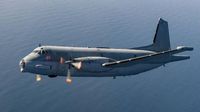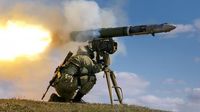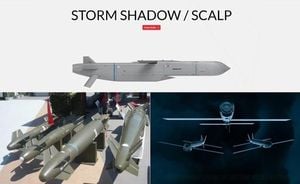On March 19, 2025, a French Navy Atlantique 2 patrol aircraft was targeted by a fire-control radar from a Russian warship while conducting surveillance in international airspace over the Baltic Sea. The incident, part of Operation Baltic Watch, has been described as an act of intimidation amidst rising tensions between France and Russia.
The French Armed Forces General Staff stated that the use of a fire-control radar—a system designed to lock onto a target before launching a missile—signals hostile intent. Despite the situation, the Atlantique 2 continued its mission, focusing on monitoring critical underwater infrastructure in the Baltic, without altering its course.
This marks the second time in recent months that a French Atlantique 2 has been illuminated by Russian radar, following a similar encounter in January involving an S-400 air defense system based in Kaliningrad. On March 4, a French Air and Space Force MQ-9A Reaper drone faced aggressive maneuvers from a Russian Su-35 fighter near Crimea, highlighting a pattern of increasing military interactions between Russian and French assets.
French Defense Minister Sébastien Lecornu condemned the Russian actions regarding the drone as "intentional, unprofessional, and aggressive," reinforcing France’s commitment to maintain operations in international waters. These events raise significant questions about the geopolitical dynamics in the region.
The incident over the Baltic Sea was not an isolated occurrence; it coincided with heightened concerns about maritime security in light of Russian military presence and actions. The French Armed Forces General Staff indicated that a fire-control radar's activation is markedly different from standard surveillance radars which passively monitor airspace. They pointed out, "Such an illumination indicates hostile intent, as it’s the final step before a missile launch." This clearly denotes a significant escalation compared to routine monitoring.
Western analysts have suggested that the actions of the Russian warship could have been a maneuver to deter the French aircraft, despite no missile being fired. The Atlantique 2, which is designed for maritime patrol and anti-submarine warfare, notably continued its task, showcasing operational resilience amid such a display of intimidation.
This was not the first time an Atlantique 2 had encountered Russian radar. In January, another aircraft from the same fleet was targeted by an S-400 system located in Kaliningrad, a Russian enclave bordered by NATO countries like Poland and Lithuania. That prior incident also occurred during a NATO mission, with the aircraft conducting surveillance over international waters. Lecornu had condemned that encounter as an "unacceptable provocation," affirming that the aggressive Russian action would not deter France from safeguarding freedom of navigation.
The recurrence of these encounters points to a broader Russian strategy aimed at asserting control over the Baltic Sea, a critical waterway for both NATO and Russian interests. This includes securing vital underwater infrastructures such as cables and pipelines, which have faced suspected sabotage recently. In December 2024, for instance, the EstLink 2 power cable connecting Finland and Estonia was damaged—a situation that prompted an increased military presence in the region, marked by NATO’s Operation Baltic Watch.
The Atlantique 2’s role in this operational theater includes low-altitude flights for gathering intelligence, possibly utilizing sonobuoys to detect submarine activity in these sensitive waters. Such actions may have prompted Russia to engage its fire-control radar, perceiving French surveillance as a direct challenge to its naval operations.
The broader context also intensifies these tensions. Following Russia's invasion of Ukraine in 2022, the security landscape in Europe has notably shifted, increasing the stakes for all military engagements in the Baltic Sea area, often referred to as a "NATO lake" due to the proximity of alliance members. Russia maintains a significant military presence in Kaliningrad, where sophisticated air defense systems like the S-400 provide it the capability to monitor NATO movements and project power into the Baltic region.
As the Atlantique 2 continues its mission near this politically charged area, the radar lock initiated by the Russian warship may be seen as Moscow’s attempt to assert dominance without escalating conflict into open hostilities.
French officials have reiterated their resolve to engage internationally in the face of Russian aggression. Lecornu clearly stated recently that incidents such as these will not alter France's strategic posture. The professionalism displayed by the French crew in continuing their mission in the face of hostility reflects a broader determination among NATO allies.
The involvement of the Atlantique 2 highlights its vital role in France and NATO’s security efforts in the region. With an impressive flight endurance of up to 14 hours and a range of approximately 4,300 nautical miles, this aircraft has been modernized since 2013, enhancing its capabilities in maritime surveillance significantly.
The dynamics between France and Russia provide essential context for these military encounters. French President Emmanuel Macron has championed efforts to strengthen defenses against Russian aggression, emphasizing the importance of supporting Ukraine’s sovereignty. In turn, Russia has consistently accused NATO of encroaching on its sphere of influence.
The Russian targeting of French surveillance assets might reflect broader frustrations regarding western military presence near its borders. While both sides navigate this tension, the actions undertaken by the French seem firmly grounded in a commitment to operational security and bilateral cooperation within NATO.
Moving forward, the tensions in the Baltic Sea will continue to unfold. NATO's increased surveillance efforts, driven by concerns over infrastructure protection, juxtapose with Russia's attempts to maintain influence in the region. The March 19 incident serves as a stark reminder of the complex interplay of military necessity, geopolitical maneuvering, and the consequential quest for dominance over critical maritime environments.





